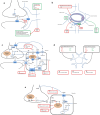Astrocyte alterations in neurodegenerative pathologies and their modeling in human induced pluripotent stem cell platforms
- PMID: 31016348
- PMCID: PMC6588647
- DOI: 10.1007/s00018-019-03111-7
Astrocyte alterations in neurodegenerative pathologies and their modeling in human induced pluripotent stem cell platforms
Abstract
Astrocytes are the most abundant cell type in the brain. They were long considered only as passive support for neuronal cells. However, recent data have revealed many active roles for these cells both in maintenance of the normal physiological homeostasis in the brain as well as in neurodegeneration and disease. Moreover, human astrocytes have been found to be much more complex than their rodent counterparts, and to date, astrocytes are known to actively participate in a multitude of processes such as neurotransmitter uptake and recycling, gliotransmitter release, neuroenergetics, inflammation, modulation of synaptic activity, ionic balance, maintenance of the blood-brain barrier, and many other crucial functions of the brain. This review focuses on the role of astrocytes in human neurodegenerative disease and the potential of the novel stem cell-based platforms in modeling astrocytic functions in health and in disease.
Keywords: Alzheimer’s disease; Amyotrophic lateral sclerosis; Astrocytes; Neurodegeneration; Parkinson’s disease.
Figures

Similar articles
-
Human Astrocytes Model Derived from Induced Pluripotent Stem Cells.Cells. 2020 Dec 13;9(12):2680. doi: 10.3390/cells9122680. Cells. 2020. PMID: 33322219 Free PMC article.
-
Co-cultures of Human-Induced Pluripotent Stem Cell-Derived Neurons, Astrocytes, and Microglia for Modeling Neurodegenerative Diseases.Methods Mol Biol. 2025;2924:75-91. doi: 10.1007/978-1-0716-4530-7_6. Methods Mol Biol. 2025. PMID: 40307636
-
α-Synuclein Oligomers Induce Glutamate Release from Astrocytes and Excessive Extrasynaptic NMDAR Activity in Neurons, Thus Contributing to Synapse Loss.J Neurosci. 2021 Mar 10;41(10):2264-2273. doi: 10.1523/JNEUROSCI.1871-20.2020. Epub 2021 Jan 22. J Neurosci. 2021. PMID: 33483428 Free PMC article.
-
Common alterations to astrocytes across neurodegenerative disorders.Curr Opin Neurobiol. 2025 Feb;90:102970. doi: 10.1016/j.conb.2025.102970. Epub 2025 Jan 28. Curr Opin Neurobiol. 2025. PMID: 39879721 Review.
-
Examining the relationship between astrocyte dysfunction and neurodegeneration in ALS using hiPSCs.Neurobiol Dis. 2019 Dec;132:104562. doi: 10.1016/j.nbd.2019.104562. Epub 2019 Aug 2. Neurobiol Dis. 2019. PMID: 31381978 Free PMC article. Review.
Cited by
-
Dual Effect of Carnosine on ROS Formation in Rat Cultured Cortical Astrocytes.Mol Neurobiol. 2024 Jul;61(7):4908-4922. doi: 10.1007/s12035-023-03880-0. Epub 2023 Dec 28. Mol Neurobiol. 2024. PMID: 38151612
-
Conditioned culture medium of bone marrow mesenchymal stem cells promotes phenotypic transformation of microglia by regulating mitochondrial autophagy.PeerJ. 2024 Jul 4;12:e17664. doi: 10.7717/peerj.17664. eCollection 2024. PeerJ. 2024. PMID: 38974415 Free PMC article.
-
Intracellular DAMPs in Neurodegeneration and Their Role in Clinical Therapeutics.Mol Neurobiol. 2023 Jul;60(7):3600-3616. doi: 10.1007/s12035-023-03289-9. Epub 2023 Mar 2. Mol Neurobiol. 2023. PMID: 36859688 Review.
-
Astrogliosis in an Experimental Model of Hypovitaminosis B12: A Cellular Basis of Neurological Disorders due to Cobalamin Deficiency.Cells. 2020 Oct 9;9(10):2261. doi: 10.3390/cells9102261. Cells. 2020. PMID: 33050187 Free PMC article.
-
Species ethnobotanical values rather than regional species pool determine plant diversity in agroforestry systems.Sci Rep. 2021 Dec 14;11(1):23972. doi: 10.1038/s41598-021-03408-3. Sci Rep. 2021. PMID: 34907238 Free PMC article.
References
Publication types
MeSH terms
Grants and funding
LinkOut - more resources
Full Text Sources
Medical

